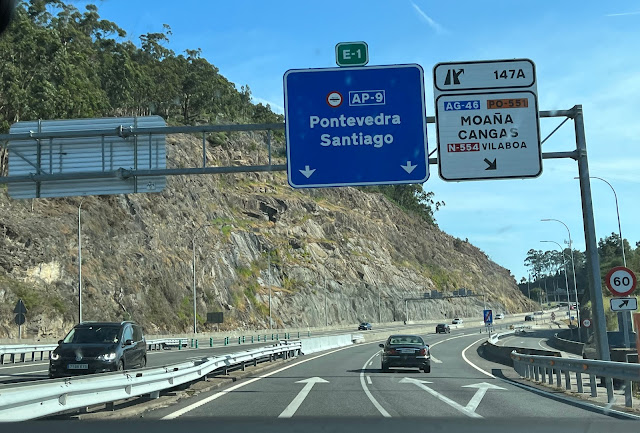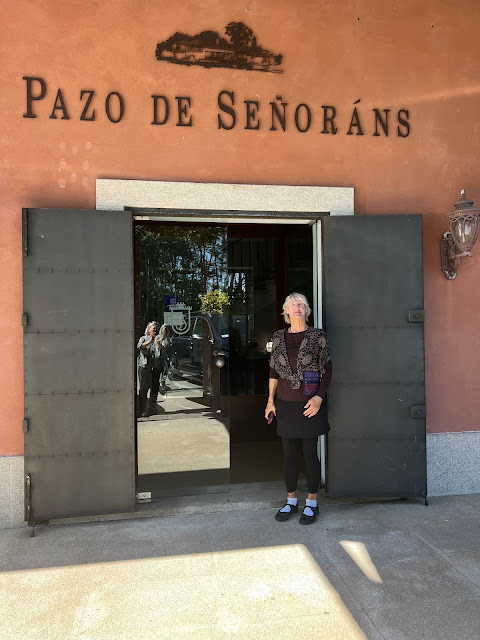Over the years I have enjoyed awesome Albariño wines from Galicia, Spain. Since first tasting Galicia's Albariño wines, mainly from Rias Baixas, I have wanted to learn more. Fortunately, the opportunity to visit Galicia presented itself when my friend Carol, and I began to plan this year's springtime travels in Spain and Portugal. Since we had heard and read so many good things about Galicia we just had to visit. In fact, we decided to begin our wine country explorations there. Our wine explorations began when we crossed into Galicia from Portugal, after a long drive from Lisbon. Indeed it was a vinous pilgrimage to discover Galician wine country.
Off to Galicia to Explore Wine Country
Soon we were viewing Albariño Vineyards from through the car windows. Albariño (Galician pronunciation [alβaˈɾiɲʊ]), or Alvarinho (Portuguese pronunciation [alvɐˈɾiɲu]) meaning white, whitish, is a white grape variety grown in northwest Portugal and Spain. While there has been some discussion about its origin, recent studies suggest this grape is native to Galicia/Portugal. Rías Baixas's Albariño is typically aromatic and acid-driven. Some have described it as having a Viognier nose, and a Riesling palate. This classic, overarching description is changing as wine producers experiment with oak aging and malolactic fermentation. Moreover, each of the area’s sub-regions brings a slightly different character to the wine.
After crossing over into Galicia we spent our first night in Vigo, a vibrant seaside city.
Next day, it was a leisurely drive north, across the Vigo estuary, and onto Santiago de Compostela. Along the way we would pass many vineyards where Albariño is grown on pergolas.
Driving to Santiago de Compostela we stopped at Pazo Señorans, a gorgeous wine property. Later we would explore the charms of Santiago and the Rutas do Viño vineyards of Rías Baixas (lower estuaries). During our Galician wine travels we explored mainly the Rías Baixas area however, later as we traveled onto Portugal's Douro Valley we would get a glimpse into its other wine appellations. Galicia has five major wine regions: Rías Baixas, Ribeiro, Ribeira Sacra, Valdeorras, and Monterrei.
Galicia's Wine Country
Albariño is native to the northwestern corner of the Iberian peninsula where it is planted both sides of Spain's and Portugal's border. It constitutes more than 90 percent of the grapes planted in Galicia's Rias Baixas area. Given the climatic variation within the Rias Baixas DO there are different sub-regions and variations between vineyards, and of course across vintages. Our very first stop was at Pazo De Señorans, a gorgeous wine property in Rías Baixas DO.
Pazo De Señorans
Here we would tour the property and do a wine tasting with the winemaker.
This is a wine estate where women are engaged in all the winery's activities.
Pazo Señorans © Spaswinefood
Welcome to Pazo Señorans © Spaswinefood
What welcome to Galicia it was! We had come to the best place to begin our wine explorations.
Pazo Señorans Wines © Spaswinefood
This wine tasting set a high bar for us to measure other Albariño wines against.
Now, I will share a few highlights from our tour of the estate.
Hórreo, Pazo Señorans © Spaswinefood
I cannot thank the staff enough for a first class visit. After such a wonderful welcome to Galicia at Pazo De Señorans, we traveled onto Santiago de Compostela.
Later, we would explore the charms of Santiago de Compostela, by wandering the traffic-free streets of its medieval centre. Pilgrims on the Camino de Santiago have long discovered the charms of Santiago de Compostela. We saw, modern-day pilgrims, as they headed for its spectacular cathedral and historic buildings. Each day we would set on our own pilgrimage along Rutas do Viño vineyards of Rías Baixas. What we discovered in Rias Baxis is that Atlantic Spain’s Galicia is a land of (1) pazos, and grand manor houses surrounded by vineyards, (2) hórreos (granaries), and (3) seafood rich estuaries fringed with vines and vegetable gardens.
Rias Baixas, is the best known of Galicia's wine areas consists of five sub-regions (Val do Salnés, Ribeira do Ulla, Soutomaior, O Rosal, and Condado do Tea). Rías Baixas wine tends to be made entirely from the Albariño variety, which comprises over 90 percent of the region’s vineyards. Increasingly producers are experimenting with oak aging and malolactic fermentation. While there is a classic, overarching style of Albariño, each of the area’s sub-regions imparts a slightly different character to the wine. A very small amount of red wine is made from the varieties Caiño, Espadeiro, and Mencía.





















